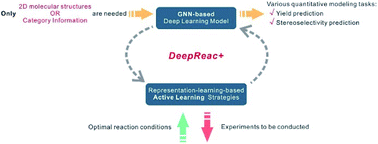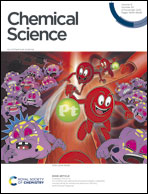DeepReac+: deep active learning for quantitative modeling of organic chemical reactions†
Abstract
Various computational methods have been developed for quantitative modeling of organic chemical reactions; however, the lack of universality as well as the requirement of large amounts of experimental data limit their broad applications. Here, we present DeepReac+, an efficient and universal computational framework for prediction of chemical reaction outcomes and identification of optimal reaction conditions based on deep active learning. Under this framework, DeepReac is designed as a graph-neural-network-based model, which directly takes 2D molecular structures as inputs and automatically adapts to different prediction tasks. In addition, carefully-designed active learning strategies are incorporated to substantially reduce the number of necessary experiments for model training. We demonstrate the universality and high efficiency of DeepReac+ by achieving the state-of-the-art results with a minimum of labeled data on three diverse chemical reaction datasets in several scenarios. Collectively, DeepReac+ has great potential and utility in the development of AI-aided chemical synthesis. DeepReac+ is freely accessible at https://github.com/bm2-lab/DeepReac.



 Please wait while we load your content...
Please wait while we load your content...